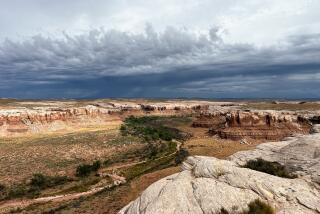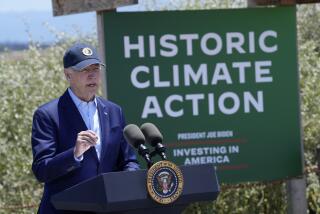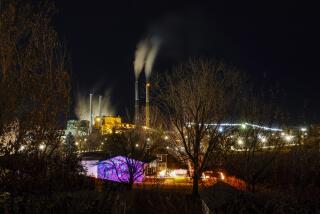A quiet OK for peaks’ removal
WASHINGTON -- With the election of President Obama, environmentalists had expected to see the end of the “Appalachian apocalypse,” their name for exposing coal deposits by blowing the tops off whole mountains.
But in recent weeks, the administration has quietly made a decision to open the way for at least two dozen more mountaintop removals.
In a letter this month to a coal ally, Rep. Nick J. Rahall II (D-W.Va.), the Environmental Protection Agency said it would not block dozens of “surface mining” projects. The list included some controversial mountaintop mines.
The industry says the practice of using explosives to blast away a peak is safer and more efficient than traditional shaft mining. But critics say the process scars the landscape and dumps tons of waste -- some of it toxic -- into streams and valleys.
The administration’s decision is not the final word on the projects or the future of mountaintop removal. But the letter, coupled with the light it sheds on relations between the mining industry and the Obama White House, has disappointed environmentalists. Some say they feel betrayed by a president they thought would end or sharply limit the practice.
The issue is politically sensitive because environmentalists were an active force behind Obama’s election, and the president’s standing is tenuous among Democratic voters in coal states. West Virginia, for example, voted for George W. Bush in the 2000 presidential election largely because Democrat Al Gore was critical of the coal industry.
Moreover, Obama needs support from local lawmakers for an energy agenda that would further regulate home-state industries, but halting mountaintop mining could eliminate jobs and put upward pressure on energy prices in a time of economic hardship.
Coal advocates have solicited help from officials as high up as White House Chief of Staff Rahm Emanuel. And the issue has sparked contentious debates within the administration, including one shouting match in which top officials from two government agencies were heard pounding their fists on the table, according to sources briefed on the meeting who requested anonymity when discussing White House dealings.
The White House is “searching for a way to walk this tightrope,” said Phil Smith, a spokesman for the United Mine Workers of America. “They have a large constituency of people who want to see an immediate end to mountaintop removal, and an equally large constituency . . . whose communities depend on those jobs.”
Shortly after his inauguration, Obama won praise from the green lobby for taking a skeptical view of the mining process. And in March the EPA announced it would review the mountaintop projects, breaking from the Bush administration’s practice of granting permits with little or no scrutiny.
The EPA has the authority to block mountaintop removal under the Clean Water Act. But if the agency raises no objections, the final decision on projects is made by the Army Corps of Engineers, which historically has approved mountaintop mining. The corps previously had indicated its intention to approve 48 pending permits.
Although environmentalists had expected the new administration to put the brakes on mountaintop removal, Rahall and other mining advocates have pointed out that Obama did not promise to end the practice and was more open to it than his Republican opponent, Arizona Sen. John McCain.
A review of Obama’s campaign statements show that he had expressed concern about the practice without promising to end it. On a West Virginia visit, when asked about the impact of the mining on the state’s streams, he said he wanted “strong enforcement of the Clean Water Act,” adding: “I will make sure the head of the Environmental Protection Agency believes in the environment.”
And his EPA administrator, Lisa Jackson, has said that the agency had “considerable concern regarding the environmental impact these projects would have on fragile habitats and streams.” She pledged that the agency would “use the best science and follow the letter of the law in ensuring we are protecting our environment.”
Soon afterward, the agency in effect blocked six major pending mountaintop removal projects in West Virginia, Kentucky and Ohio.
But this month, after a series of White House meetings with coal companies and advocates including Rahall and Democratic West Virginia Gov. Joe Manchin III, the EPA released the little-noticed letter giving the green light to at least two dozen projects.
“It was a big disappointment,” said Joan Mulhern, a lawyer for Earthjustice, an environmental law firm that has led court challenges to mountaintop removal. “It’s disturbing and surprising that this administration, headed by a president who has expressed concern about mountaintop removal, would let such a large number of permits go forward without explanation.”
Mulhern charged that the EPA “blew off” Jackson’s earlier promises that the agency would adhere to science and would conduct an open process.
Ed Hopkins, a top Sierra Club official, said some of the projects that have now obtained the EPA’s blessing “are as large and potentially destructive as the ones they objected to.”
“It makes us wonder what standards -- if any -- the administration is using,” Hopkins said.
EPA and White House officials say that about 200 proposed mining projects are under review and that the administration already had taken steps to break from Bush-era policies.
“We want to make informed decisions guided by science and the law, and a change in such a practice is not something that happens overnight,” said Christine Glunz, a spokeswoman for the White House Council on Environmental Quality.
But after the EPA’s initial announcement in March that it would conduct aggressive reviews, Manchin and Rahall took the coal industry’s concerns to White House officials, including Emanuel and Nancy Sutley, who heads the Council on Environmental Quality.
Manchin said he told the White House that “we are looking for a balance between the environment and the economy, and they assured me that they will work with us to find that balance.”
Environmentalists were stunned to learn from Rahall’s office May 15 that the EPA had given its blessing to 42 out of the 48 mine projects it had reviewed so far -- including two dozen mountaintop removals.
The news came in a letter to Rahall from Michael Shapiro, the EPA’s acting assistant administrator, who wrote, “I understand the importance of coal mining in Appalachia for jobs, the economy, and meeting the nation’s energy needs.”
--
--- START OF CORRECTION ---
For The Record
Los Angeles Times Thursday, June 04, 2009Home Edition Main News Part A Page 4 National Desk1 inches; 42 wordsType of Material: Correction
Mountaintop mining: A headline on an article in Sunday’sSection A said mining had been approved on mountain peaks. The
Environmental Protection Agency said it wouldn’t block the miningprojects, but the final decision is up to the Army Corps ofEngineers.For The RecordLos Angeles Times Sunday, June 07, 2009Home Edition Main News Part A Page 4 National Desk1 inches; 44 wordsType of Material: Correction
Mountaintop mining: A headline on an article in the May 31Section A said mining had been approved on mountain peaks. TheEnvironmental Protection Agency said it wouldn’t block the miningprojects, but the final decision is up to the Army Corps ofEngineers.--- END OF CORRECTION ---
By Tom Hamburger and Peter Wallsten,
More to Read
Sign up for Essential California
The most important California stories and recommendations in your inbox every morning.
You may occasionally receive promotional content from the Los Angeles Times.










